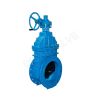What is the difference between resilient seated and metal seated gate valves?
Feb. 26, 2024
Functionality and Characteristics
Resilient seated gate valves and metal seated gate valves are two common types of valves used in various industrial applications, each with its unique functionality and characteristics.
Resilient Seated Gate Valves
Resilient seated gate valves feature a flexible, non-metallic seating surface typically made of rubber or EPDM. This resilient material provides a tight seal against the gate, ensuring leak-free performance when the valve is closed. Resilient seated gate valves are known for their excellent sealing properties, making them ideal for applications where tight shut-off is essential, such as water distribution systems, sewage treatment plants, and irrigation systems. They offer ease of operation, cost-effectiveness, and lightweight construction, making them suitable for a wide range of municipal and industrial applications.
Metal seated gate valves, on the other hand, utilize metal-to-metal contact between the gate and the valve body for sealing purposes. Typically, both the gate and the valve body are machined to precise tolerances to achieve a tight seal when the valve is closed. Metal seated gate valves are known for their durability and resistance to wear, making them suitable for applications involving high temperatures, high pressures, or abrasive media. They are commonly used in industries such as oil and gas, chemical processing, and power generation, where reliable performance under harsh operating conditions is critical.

Advantages and Disadvantages
Both resilient seated and metal seated gate valves offer distinct advantages and disadvantages based on their design and materials.
Resilient seated gate valves are favored for their excellent sealing properties, ease of operation, and cost-effectiveness. However, they may not be suitable for applications involving high temperatures or abrasive media, as the resilient material may degrade over time.
Metal seated gate valves, on the other hand, offer superior durability and resistance to wear, making them suitable for demanding applications with high temperatures, pressures, or abrasive media. However, they may be more expensive and require more maintenance compared to resilient seated gate valves.
Differences in Performance Indicators
When selecting between resilient seated and metal seated gate valves, several performance indicators should be considered, including:

Sealing performance: Resilient seated gate valves offer excellent sealing performance under normal operating conditions, while metal seated gate valves provide superior sealing performance in harsh environments.
Durability: Metal seated gate valves are more durable and resistant to wear compared to resilient seated gate valves.
Operating conditions: Resilient seated gate valves are suitable for applications with moderate temperatures and pressures, while metal seated gate valves are preferred for high-temperature, high-pressure, or abrasive media applications.
Conclusion
In conclusion, the choice between resilient seated and metal seated gate valves depends on the specific requirements of the application, including operating conditions, pressure ratings, temperature ranges, and media characteristics. By understanding the functionality, advantages, and disadvantages of each type of valve, engineers and specifiers can select the most suitable valve for their particular needs, ensuring optimal performance and reliability in their systems.
511
0
0
All Comments (0)
Previous: What is the difference between a gate valve and a wedge valve?
Next: None
If you are interested in sending in a Guest Blogger Submission,welcome to write for us!


Comments